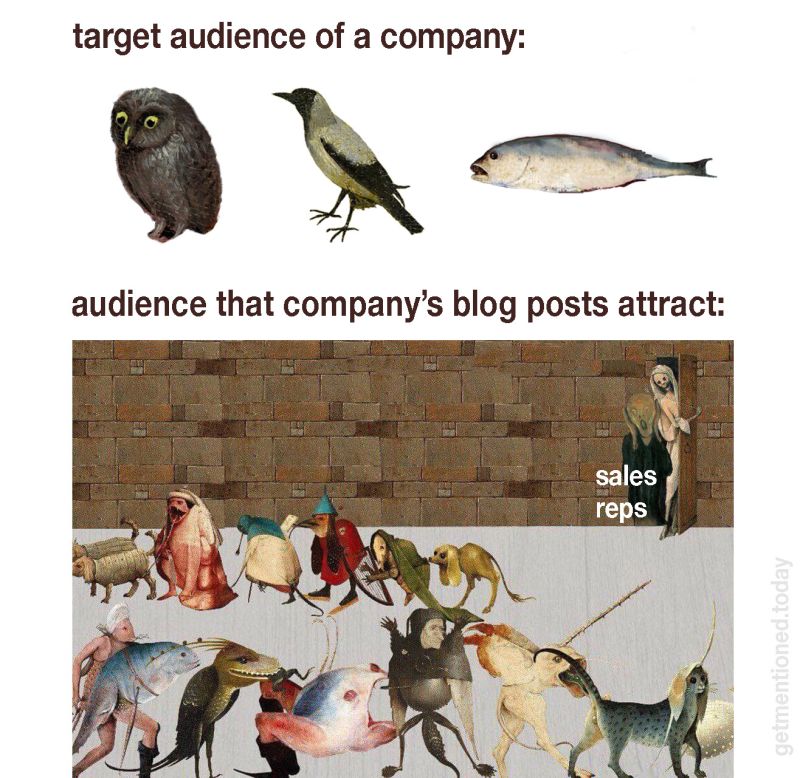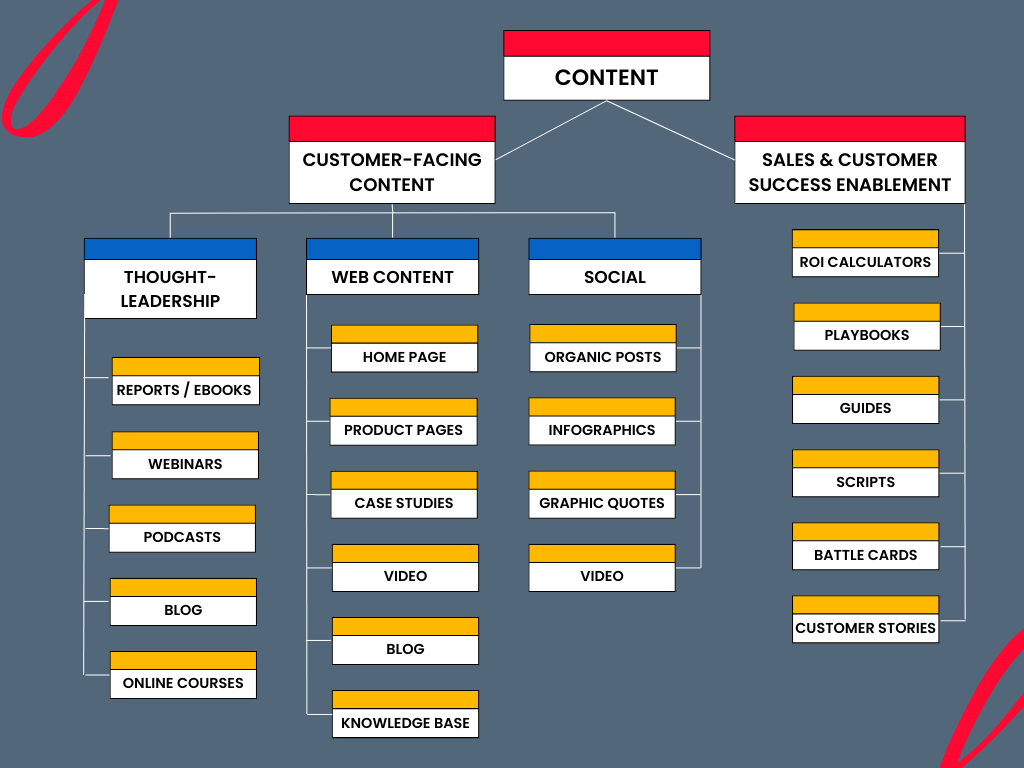78% of companies that have seen successful results in their content marketing activities have a content marketing strategy in place*.
And while achieving some success without a strategy (the remaining 22%) is possible, it might be an outcome of short-term campaigns. But at the end of the day, running a B2B content marketing program with no content strategy is like:
- Traveling the country without a map
- Directing a movie without a script
- or assembling a piece of IKEA furniture with no instruction.
In this guide, you will dive into 10 foundations of a rock-solid B2B content marketing strategy you can take away to implement in your company.
Plus, you will find insights and 2023 predictions from seasoned marketing experts from brands like Heap, Avoma, ClickMeeting, Traffit and more!
Let’s do this!
What is Content Marketing Strategy
Content strategy is a structured vision of planning, creating, distributing, analyzing, and optimizing all your content to achieve tangible results aligned with your business goals.
Think of content strategy as a roadmap and a centralized hub where you can orchestrate all the campaigns, creative assets, resources, and sync with internal stakeholders and external providers, to turn strangers into customers.
Now, many marketers identify content strategy with creating SEO content, running a YouTube channel, or hosting podcasts and webinars. As much as each of those is a great idea to get traction, they should fall under a distribution channel or a tactic category.
This takes us to bust some more myths that exist in the B2B marketing world:
Why Content Marketing Strategy is Essential for B2B
When no content marketing strategy is set in stone, all marketing activities are all over the place.
Trust me, I’ve been working for (and with) numerous B2B companies, and I’ve seen a lot:
- Stakeholders being obsessed with quick wins and low-hanging fruits but very skeptical towards long-term planning (we don’t have time for that!)
- Misalignment between marketing and sales or customer success teams – working in silos instead of being in sync with each other.

- Marketing activities being detached from one another — one plan for paid social and paid search, another for SEO content, another for video marketing, and another for email marketing and customer onboarding.
- The variety of blog topics so broad that it’s hard to understand the target audience of a specific brand.
Quoting Yaagneshwaran Ganesh – Director of Content Marketing at Avoma:
Never write a piece of content just because a keyword has search volume or your competitors rank for it. Write because you have a unique PoV and only if it would help your audience.

In contrast, an ideal scenario is where:
- You’re playing the long game where there is an overarching content strategy with buy-in from all your stakeholders.
- Content marketing is about working closely with sales and customer success teams to deliver what they need in direct communication with leads and customers.
- All marketing campaigns are aligned to one strategy.
- The content you produce is not about everything for everyone, but it perfectly matches your buyer persona’s pain points and interests.
Now, achieving the above can be challenging because it comes with many moving parts (for example — teams or employees competing against each other). But, even if it doesn’t get close to perfection, implementing a solid content strategy will help you:
- generate higher traffic to your website
- land more leads
- convert leads into closed sales deals
- onboard and retain your customers more efficiently
- optimize your CAC
That said, let’s dive into our step-by-step guide!
10 Foundations of a Rock-Solid B2B Content Marketing Strategy
1. Know Your Audience
Skipping this part is a road to failure. Not knowing who you’re talking to means burning your campaign budget and wasting resources on creating your website copy, blogs, and all the rest of your content that WON’T strike the chord.
In turn, if you invest in the market and customer research first, you will know precisely how to craft all your content. This is the philosopher’s stone of marketing.
How important is conducting customer research in terms of building a content strategy? Ben Lempert, Director of Web and Content at Heap, has no doubts:
Oh, it’s critical! Content marketers sometimes imagine that prospects are these semi-human receptacles that have all sorts of free time to browse the stuff you’re putting out into the world. They don’t! Your prospects are just like all of us: busy, stressed, and worried about doing their jobs well. If your content can’t speak to their problems and needs, you can’t realistically expect your prospects to take the time to read it.
Put differently: your content needs to earn the right to be read. (Or watched or listened to) The best way to earn that trust with your audience is to know what they care about. What keeps them up at night? What thing, if they could do it better, would get them promoted? Figure out those questions, and you’ll have the foundation you need to be a successful content marketer.
That goes back to understanding the pains and the gains of whoever you target. That’s why serious content marketers should think and act like product marketers who treat the voice of customer data as a pillar of their work.
Now, there are a few ways to pull this of:
- Qualitative data — which means conducting video interviews — from my experience, there’s no better formula to understand a target audience deeply. I’ve run dozens of interviews, and each of them (oh, how they were different from each other) delivered me golden insights for our clients. Look at this real-life snippet from an interview: „The biggest challenge is understanding that if you don’t act proactively at the right time, you will be behind in the game forever.” WOW!
Marcos Bravo, Brand, Content, Social Media Consultant, Founder @ The Waterlemon also highlights the importance of this part:
Talking to your customer or ICP will give you so much more info that trying to swing your way between a/b testing and SEO. You can literally go directly to the source.
- Quantitative data — this boils down to polls and surveys. Even though marketers tend to skip the interviews, and run surveys right off the bat, I wouldn’t recommend that. Why? Because of the unconscious bias. Closed-ended questions forcefully push respondents into assumptions concocted by marketers. The way to get out of this trap is to listen carefully to interview recordings, finding patterns, and populating the list of survey answers with answers delivered during the interviews.
Customer research is the foundation to make your content strategy work. — says Sara Lattanzio, Freelance Content Strategist & Sr. Marketing Manager @ Adnovum. — Most companies sleep on collecting customer insights and have no process in place to do it. It’s quite difficult to establish, especially for mid-sized and large companies, because it requires strong cross-departmental collaboration.
Tomasz Bołcun, Brand Manager at ClickMeeting is even more radical about that:
It’s key and bloody important! How are you supposed to know what your current and potential customers want to listen to if you don’t ask them if you don’t pull and analyze purchase and product data? What worked and was valid just six months ago in many industries is now obsolete.
For example, the webinar and video conferencing industry has undergone a pandemic-accelerated evolution over the past 3 years. Customers have rapidly professionalized, and speaking to them in the language of benefits from 2 years ago, focusing on explaining what webinars are, would be an outright anachronism.
Therefore, do surveys, review feedback data, keep up to date with your and your competitors’ reviews, and look at the product database regularly.
2. Run Competitive Intelligence
Another cornerstone of your content marketing strategy is about understanding the market. You will always have some competitors — direct or indirect. Although it might be tempting to sweep them under the carpet or hate them, learning from them will bring much more value to the table.
Where to start with competitive intelligence? If you already know who your competitors are, you can go to their websites and social media and get the complete picture of:
- Their products and services
- Values and benefits they highlight in their messaging
- The tone of voice in their copywriting
- Content types they invest in — is it just blog, or do they cover webinars and podcasts?
It comes with additional costs, but you have several platforms at your disposal to dig into:
- Organic traffic of your competitors — whether you choose Ahrefs or Semrush, you can enter your competitors’ websites and check the volume of their traffic, backlinks, organic keywords, and positions in search results. You can see what’s their best-performing content and what are their most vital keywords. As for keywords, my favorite tool within the Semrush platform is the Keyword Gap, where you compare yourself to five competing websites. The result? You get to know where you are strong and where weak, and, most importantly — you discover plenty of untapped keywords.
- Market research — to get a bird’s-eye view of your market, total traffic trends, market geo-distribution, demographics, or market share by distribution channel, check Semrush’s Market Explorer tool. Here’s an example of data you can generate by entering your website over there:
You can try out other software for marketing intelligence: Kompyte or Compete Shark.
- Audience intelligence — the good news is there are also a few apps that can help you take your competitors’ audience under the microscope. Try out platforms like Sparktoro or Audiense, and dive into the characteristics of the audience that follows your competitor’s social media accounts — their demographics, job titles, what they read, listen, and watch on the Internet, what phrases and hashtags they use, and what their online buying habits. This data will hint at what content you need to produce and where to distribute it.
3. Craft Your Messaging
The last part of building a foundation for your content marketing is using data and insights from customer research and competitive / audience intelligence to create or refine your messaging. That means defining what you will communicate with your content, to whom and how.
This part shouldn’t be happening in a silo. Talk to people from your sales, customer support, and product teams. Invite them to a series of workshops where you will present the results of your research.
Collaborate closely to come up with the following:
- The Why — where you will craft a strategic narrative that speaks to your ideal customers’ values, goals, benefits, and buying requirements.
- The Who — where you will segment messaging by function, industry, jobs-to-be-done, and location.
- The What — where you will work on the solution messaging: describing your audience’s pains and negative consequences if they don’t overcome those challenges, the ideal state, and positive outcomes if they manage to overcome those pain points, required capabilities, and metrics.
- The How — which will lead to creating product-focused messaging — explaining how the product works and how it delivers.
4. Set up Your Business Goals
Churning out tons of content without aligning it with your business goals is a common misconception. This stage is the heart of your B2B content marketing strategy. Collaborate with all the stakeholders, and map out:
- Challenges your company faces — for example, high customer churn or low acquisition.
- Financial goals — let’s say you have to increase the income up to a specific amount monthly.
- New product releases you’re going to launch this year.
Having that in place, think of how your content marketing activities help you overcome challenges or deliver tangible results.
Brainstorm a list of hypotheses that will translate into your content goals. For example:
- It’s getting costly to land new leads, but we have 10k email subscribers in our base that we need to do something about. So, we’re placing a bet that creating a lead nurturing architecture, creating five separate email sequences for different audience segments, and redirecting your potential customers to a set of landing pages will help us generate X sales calls. And that number of calls will deliver Y closed deals generating a Z income.
Try the same approach with different challenges and goals, list them, and prioritize them. That will determine your content strategy.
Once you’re ready, create timelines for each program and:
5. Determine Your Budget
Plans can be ambitious, but at the end of the day, you need to be realistic about the financial side. Look at the timeline with your list of campaigns, and break them down into deliverables. For example:
- Campaign number 1 will require: writing and designing 15 emails, writing, designing, and developing 10 landing pages, 5 paid social ads, budget for setting up and optimizing a campaign.
- Campaign number 2 will require 10 long-form articles, 5 newsletters, 30 organic social posts, 10 paid social ads, and a budget for setting up and optimizing the campaign.
- Campaign number 3 will require: organizing a webinar, writing and designing 5 emails, 2 landing pages, 2 paid social ads, budget for setting up and optimizing the campaign.
Creating content costs. So does the distribution. Regardless of whether you handle all that internally or outsource it (partially or entirely).
Having the numbers in front of you, decide how much money you can allocate to each campaign.
6. Map Out Your Content Operations
Speaking of handling content tasks in-house or with the help of freelancers and agencies — you reach a moment where you need to organize your workflow.
It will all depend on how many people work in your marketing team (writers, designers, video editors, email marketers, PPC specialists, etc.) and their capacity.
Suppose you have enough workforce to cover all the deliverables and operational tasks internally — excellent! Then it’s time to assign tasks and start creating briefs.
But if you already see that you will face bottlenecks at some stage, it’s time to look for some outside help. Consider what aspects you can manage with your team and what you need to outsource.
7. Build Your Content Structure
In terms of your content goals and campaigns, you already know what content types you need to produce to achieve results.
But it’s also worthwhile to have an inventory of your content assets. At the very top level, you need to divide your content into two categories:
- Customer-facing content — here, you can place everything targeted for your prospects, leads, and customers: blogs, website copy, emails, organic social posts, paid social ads, ebooks, webinars, podcasts, etc.
- Sales and customer support enablement content — anything that will help your front-line teams to win, educate, and retain customers: tools, ROI calculators, playbooks, guides, product demo scripts, battle cards, and success stories.

Having a structure with all content types that fall under those categories, you can decide where to invest your efforts.
If you’re struggling to decide which way to go, here are some hints from Sara Lattanzio, who shares what worked and didn’t work for her in 2022:
What worked:
– Research reports, also in collaboration with partners.
– Case studies are always gold in building social proof and strengthening relationships with existing clients.
– Organic social content optimized for in-feed consumption, particularly low-polished videos with employees.
– In-person events, both self-hosted and sponsored, combined with thought leadership.What didn’t work:
– Anything that wasn’t well planned with a specific outcome in mind or one-off experiments. Good things take time (and planning)
– Cold lead-gen ads
– Display ads
8. Create an Action Plan
Once you have figured out goals, timelines, content ops, and formats, it’s time to orchestrate all your activities.
Creating Gantt charts and tasks in project management tools like Asana or ClickUp is a must. But aside from that, it’s essential to establish some ground rules documentation or standard operational procedures about:
- Delivery time — each delay can turn a content campaign upside down. And curveballs can come from either internal or external creators. Your in-house team members can be overloaded with other tasks, and freelancers or agencies can be juggling with other projects. So, be strict about the deadlines.
- Reviewal process — it might be tempting to secure yourself by sending a piece of content to as many stakeholders as possible, but that can get quickly out of hand. It’s way more efficient to limit the number of people who will add comments to your emails and articles to a minimum.
9. Produce and Distribute Your Content
OK, time to get that ball rolling and create all your content assets – from copywriting, through design, up to videos and ads! To minimize the number of edit rounds and back-and-forth communication between you and creators and between you and stakeholders, be super specific in content briefs (and ensure you’re on the same page with stakeholders before you send out the briefs).
And after a round of tweaks and edits, you are ready to publish and start the distribution, making the most out of:
- Email marketing
- Organic social
- Paid social
- Paid media (paid newsletters or ads)
- Being present at online events
- Spreading the word inside your communities
- Video (TikTok and YouTube)
- Cross-promoting with your business partners
10. Measure Results of Your B2B Content Marketing Strategy
I’ve seen too many content campaigns being shipped and conducted but left without reassessment and conclusions. And running content just for the sake of it, and rushing towards a new shiny object, will be a huge time and money waste. Not mentioning the frustration.
So, carve out some time to collect and analyze the results. Present it to your stakeholders and measure how much you were accurate with your initial assumptions:
- Did you manage to reach the KPIs included in your B2B content marketing strategy?
- Did those campaigns affect your business’s bottom line?
- Did you catch the goal of 70%, 80%, or maybe 100%
- What could be managed differently and optimized for better results?
And finally — it’s time to conclude if you’re going to continue a specific program or invest time and resources elsewhere.
4 Tactics to Reinforce Your B2B Content Marketing Strategy
OK, so that was the content strategy. But there are also additional areas that you can plug into content marketing work:
1. Double-down on Customer Onboarding Content
Customer acquisition is not getting any cheaper. And the customers’ willingness to purchase has declined over the last few years.
So, instead of trying to boil the ocean and burn your performance marketing budget to get so-so effects, you should focus on customer retention. This is where creating marketing automation workflows with supporting content comes into play!
2. Create Sales and Customer Success Enablement Content
Content doesn’t end on customer-facing classics such as blogs and ebooks. Both — sales and customer support teams need content from you.
It’s always best to ask them directly what would work best. But you can suggest creating guides, scripts for demo calls, battle cards, customer success stories (not the same as case studies), or ROI calculators.
3. Get More Traction with Original Data
Nothing attracts more brand mentions and organic backlinks than publishing reports based on first-party data.
As Tomasz Bołcun, Brand Manager at ClickMeeting convinces:
People are fed up with copy / paste content. If you create a valuable report with analysis and data that no one has ever heard of, you increase the chances that high-profile sites will link to your article. Moreover, this way you will increase those chances even more, if data and insights you share are up to date, and answers the current questions of your target audience. Yes, that costs some extra time, but believe me, it’s worth it. Your statement or an excerpt from the article may be quoted in widely read media, and your brand or product will gain additional reach, a channel to reach your target audience, and credibility in the eyes of your audience and… Google. In ClickMeeting, we create an industry „State of online events” report once a year based on market research and share the results with the media.
4. Develop Content Marketing Partnerships
Think about content distribution before you even start creating content. One way to do that is to partner up with another company that is not your competitor but has a similar audience. This way, each party can tap into their partner’s (email and social media) audience — win-win!
Examples? Backlinko’s and BuzzSumo co-branded research and webinar, or LogicBroker and ShipStation’s joint case studies.
Content Marketing in 2023 — Expert Round Up
What would be the best way to build a B2B content marketing strategy for 2023?
Ben Lempert — Director of Web and Content at Heap:
Although companies will be looking to cut budget in 2023, I firmly believe that the best way to build a B2B content marketing strategy in 2023 is to do what you should always do when building a B2B content marketing strategy: you figure out what information will be most useful to your prospects, then build a robust content strategy that focuses on their needs.
It’s easy to create content that promotes your product. It’s much harder to create content that prospects are willing to take time out of their days to read. Like all of us, people want ideas that can help them do their job better. Your product might be a part of that, but if it’s the sole focus of your content, that content just won’t provide value
Sara Lattanzio — Freelance Content Strategist & Sr. Marketing Manager, Adnovum:
People have way more content than they can consume nowadays, so the best way to build a content strategy should start with your audience’s pain points and needs. Not SEO tools, not from what your competitors are doing – and certainly not from your assumptions.
Create content around those problems showcasing your expertise in solving them, and showing why and how your offering fixes those problems.
Focus on providing a solution with your offering, not on the offering itself, and give away as much as you can for free in your content. Don’t wait for people to discover your site, but become an active part of the communities where your ideal customers hang out and share your content there.
Marcos Bravo — Brand, Content, Social Media Consultant, Founder @ The Waterlemon:
By simply understanding who we are selling to and how they talk. Content has to go through the same process of distillation that the messaging goes through. Look at the big picture and remember that the strategy is a whole and not individual gains. Put yourself in your customer’s shoes.
Tomasz Bołcun — Brand Manager at ClickMeeting:
2023 will belong to creating content based on 1st-party data, original research, and unique expertise in the field or marketing category, where you as a brand feel most confident. Don’t try to turn your marketing channels or blog into a media outlet. Focus on one area or topic where you are an expert. The area that’s been aligned with „the why” of your brand.
Supporting that with use cases, case studies, and recognizable expert opinions has proven its worth and will continue to do so.
It will become increasingly important for two reasons:
First, B2B customers are knowledgeable people who consume a lot of industry content before making a purchase decision. As a result, they are already weary of reading another copy-cat article such as „7 ways to use marketing automation in…” etc., which are just slightly altered versions of a blog post that displays high in organic results. You can’t expect such content to bring links or increase engagement on the website.
Secondly, Google knows about the weariness of the audience with reproducible content written for SEO. All subsequent changes to Google’s search engine algorithm aim to improve the quality and promotion of content written for people and with them in mind.
→ Expertise, Authoritativeness, and Trustworthiness.
Andrzej Orłowski – Kryłowski — B2B Marketing Strategist, Head of Marketing @ Traffit:
Besides typical strategic factors, 2023 is worth:
– Amplifying the voice of satisfied customers through multiple channels.
– Observing AI development and avoiding creating types of content that AI could do. It will be more important to determine what content not to create than what content to create.
– Creating practical content based on authentic experience and, preferably — unique data.
– Including content for purchasing committees, not only for users.
– Emphasizing on creating content that supports sales rather than just generating leads.
– Considering all possible contact points with a potential client through which content can be delivered.
– Considering all possible types of content: text, voice, video, infographics, gifs, memes, etc.
What tactics have proven to be successful and which have not in 2022?
Yaagneshwaran Ganesh — Director of Content Marketing at Avoma:
Podcast is a key channel if you use it effectively — be it your own podcast or where you go as a guest. But have the right expectations — it won’t instantly capture demand on scale. But over time, your takes will attract those who believe in your values. You will generate demand instead of merely capturing.
Marcos Bravo:
Jumping on every new channel showed that we are still figuring things out. The downfall of Twitter, the loss of Clubhouse, the 15 minutes of fame of BeReal. So much effort and money into every new shiny channel. On the bright side, more and more marketers are going back to the basics of building a brand before making noise, understanding that the customer journey is real and they need to focus on many things at once. Back to basics baby!
Ben Lempert:
Well, it depends on the medium, but in general the tactics that have been successful have been those that gave prospects something truly usable. On the SEO side, for example, Google is getting better and better at promoting content that clearly and directly answers the questions users are searching for. (Well, mostly. I still hate that every recipe has to be preceded by 5 pages of memoir.) There’s a reason why Wikipedia is so popular – it does a great job of this!
On the demand side, our most successful assets are always guides, worksheets, and other mostly vendor-agnostic content. We have a how-to series that’s been very popular. Blogs written by our engineers have also garnered a lot of traffic. It’s low-intent traffic, but it’s great for brand-building.
What activities and channels will you prioritize in 2023?
Sara Lattanzio:
Working on sales and marketing alignment is key, and it requires constant adjustment.
From a content marketing perspective, we want to strengthen collaboration with our subject matter experts and improve content distribution and repurposing, both paid and organic.
Spending more time on distribution than on creation and creating already with distribution in mind are the nuts to crack here.On the personal front, I hope to add a second social media channel where I can repurpose my LinkedIn content and reach a new audience. Probably Twitter or Youtube (shorts).
Marcos Bravo:
Less popular search engines and minimizing the social media strategy. I’m pushing every brand I work with to stick to 1-2 channels and add quality to every other touch point. Personally I ditched Twitter and Facebook and stayed on Linkedin.
Tomasz Bołcun:
Our upcoming year will mark content partnerships, case studies, more user reviews and video content. We are a webinar company, so we also want to maintain the number of a minimum of 12 live webinars per year. I do not include on-demand webinars here, of course.
Ben Lempert:
Like all companies, we’re trying to do more with less. So I’m looking forward to prioritizing thought leadership content and content that delivers actionable information to prospects in our space. Things are going to get scrappier everywhere, so content that helps prospects deal with this environment is going to be enormously useful.
Andrzej Orłowski – Kryłowski:
Activities and channels must be tailored to a business’s character and target group. It is worth considering the different tones of voice on various channels. It is even more important that communication is diversified, so it should be a mix of messages: sales, education, entertainment, engaging, etc.
Build your new B2B content marketing strategy
You know what to avoid. And you know that content strategy is NOT a set of trendy hacks. Be obsessed about your audience (thanks, Jeff!) — talk to them, and speak their language. Next, craft a content strategy that will deliver something valuable to them AND align with your business goals.
What are your experiences with content strategy? Drop me a line in a comment.







